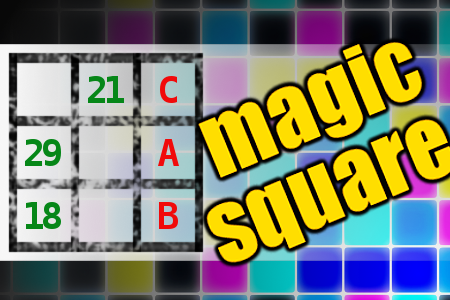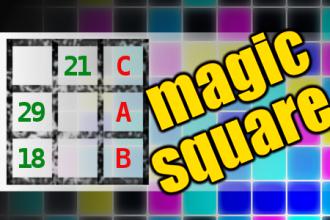MAGIC SQUARE: Calculate A*B-C
The aim is to place the some numbers from the list (6, 10, 14, 18, 21, 22, 25, 26, 29, 45) into the empty squares and squares marked with A, B an C. Sum of each row and column should be equal. All the numbers of the magic square must be different. Find values for A, B, and C. Solution is A*B-C.Correct answers: 23
The first user who solved this task is Djordje Timotijevic.
#brainteasers #math #magicsquare

A farmer named Seamus had a ca...
A farmer named Seamus had a car accident.
In court, the lorry company's fancy hot shot solicitor was questioning Seamus.
"Didn't you say, to the Garda at the scene of the accident, 'I'm fine,'?" asked the solicitor.
Seamus responded, "Well, I'll tell you what happened. I had just loaded my favorite cow, Bessie, into the..."
"I didn't ask for any details," the solicitor interrupted. "Just answer the question. Did you not say, at the scene of the accident, 'I'm fine!'?"
Seamus said, "Well, I had just got Bessie into the trailer and I was driving down the road...."
The solicitor interrupted again and said, "Your Honor, I am trying to establish the fact that, at the scene of the accident, this man told the Garda on the scene that he was fine. Now several weeks after the accident he is trying to sue my client. I believe he is a fraud. Please tell him to simply answer the question."
By this time, the Judge was fairly interested in Seamus's answer and said to the solicitor, "I'd like to hear what he has to say about his favorite cow, Bessie".
Seamus thanked the Judge and proceeded. "Well as I was saying, I had just loaded Bessie, my favorite cow, into the trailer and was driving her down the road when this huge lorry and trailer came through a stop sign and hit my trailer right in the side. I was thrown into one ditch and Bessie was thrown into the other. I was hurt, very bad like, and didn't want to move.
However, I could hear old Bessie moaning and groaning. I knew she was in terrible shape just by her groans. Shortly after the accident a garda on a motorbike turned up. He could hear Bessie moaning and groaning so he went over to her. After he looked at her, and saw her condition, he took out his gun and shot her between the eyes.
Then the Garda came across the road, gun still in hand, looked at me, and said, 'How are you feeling?'"
"Now... what would you say?"
In court, the lorry company's fancy hot shot solicitor was questioning Seamus.
"Didn't you say, to the Garda at the scene of the accident, 'I'm fine,'?" asked the solicitor.
Seamus responded, "Well, I'll tell you what happened. I had just loaded my favorite cow, Bessie, into the..."
"I didn't ask for any details," the solicitor interrupted. "Just answer the question. Did you not say, at the scene of the accident, 'I'm fine!'?"
Seamus said, "Well, I had just got Bessie into the trailer and I was driving down the road...."
The solicitor interrupted again and said, "Your Honor, I am trying to establish the fact that, at the scene of the accident, this man told the Garda on the scene that he was fine. Now several weeks after the accident he is trying to sue my client. I believe he is a fraud. Please tell him to simply answer the question."
By this time, the Judge was fairly interested in Seamus's answer and said to the solicitor, "I'd like to hear what he has to say about his favorite cow, Bessie".
Seamus thanked the Judge and proceeded. "Well as I was saying, I had just loaded Bessie, my favorite cow, into the trailer and was driving her down the road when this huge lorry and trailer came through a stop sign and hit my trailer right in the side. I was thrown into one ditch and Bessie was thrown into the other. I was hurt, very bad like, and didn't want to move.
However, I could hear old Bessie moaning and groaning. I knew she was in terrible shape just by her groans. Shortly after the accident a garda on a motorbike turned up. He could hear Bessie moaning and groaning so he went over to her. After he looked at her, and saw her condition, he took out his gun and shot her between the eyes.
Then the Garda came across the road, gun still in hand, looked at me, and said, 'How are you feeling?'"
"Now... what would you say?"

